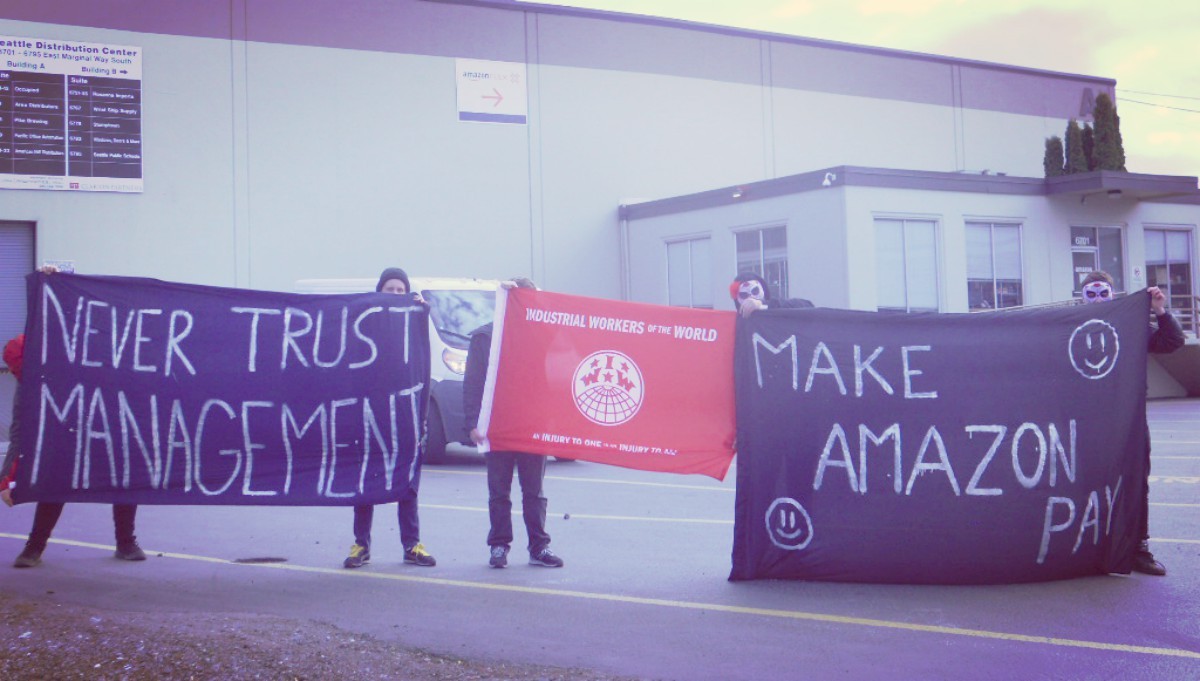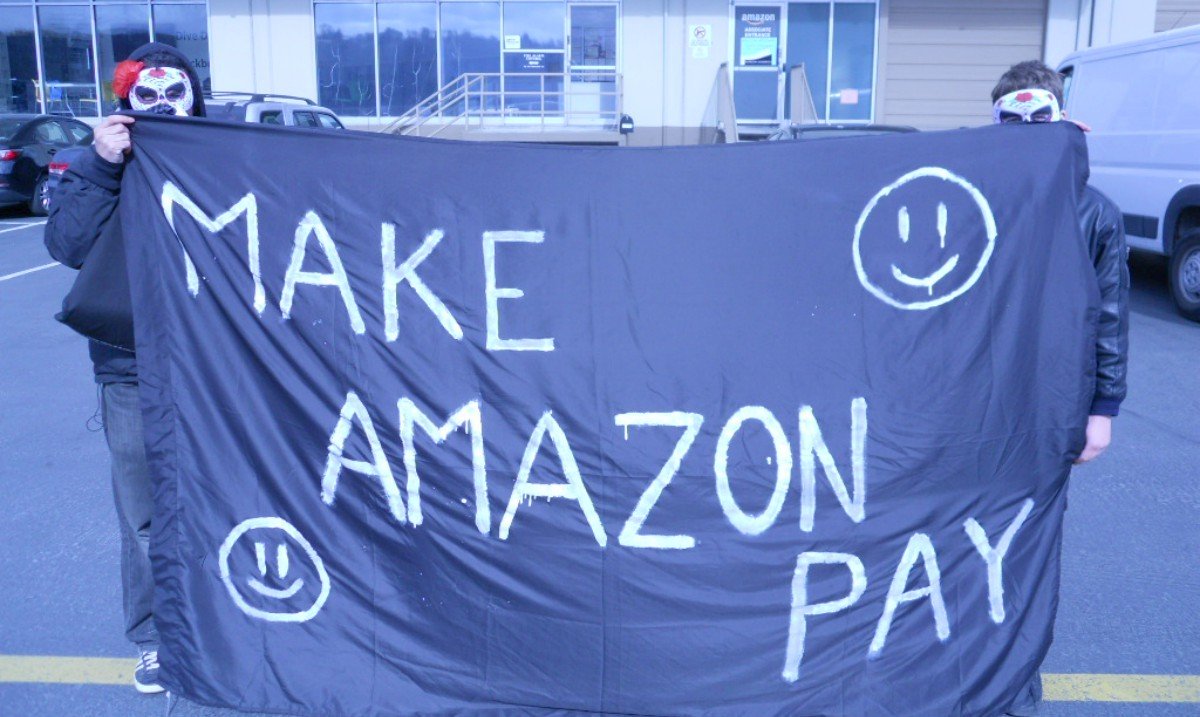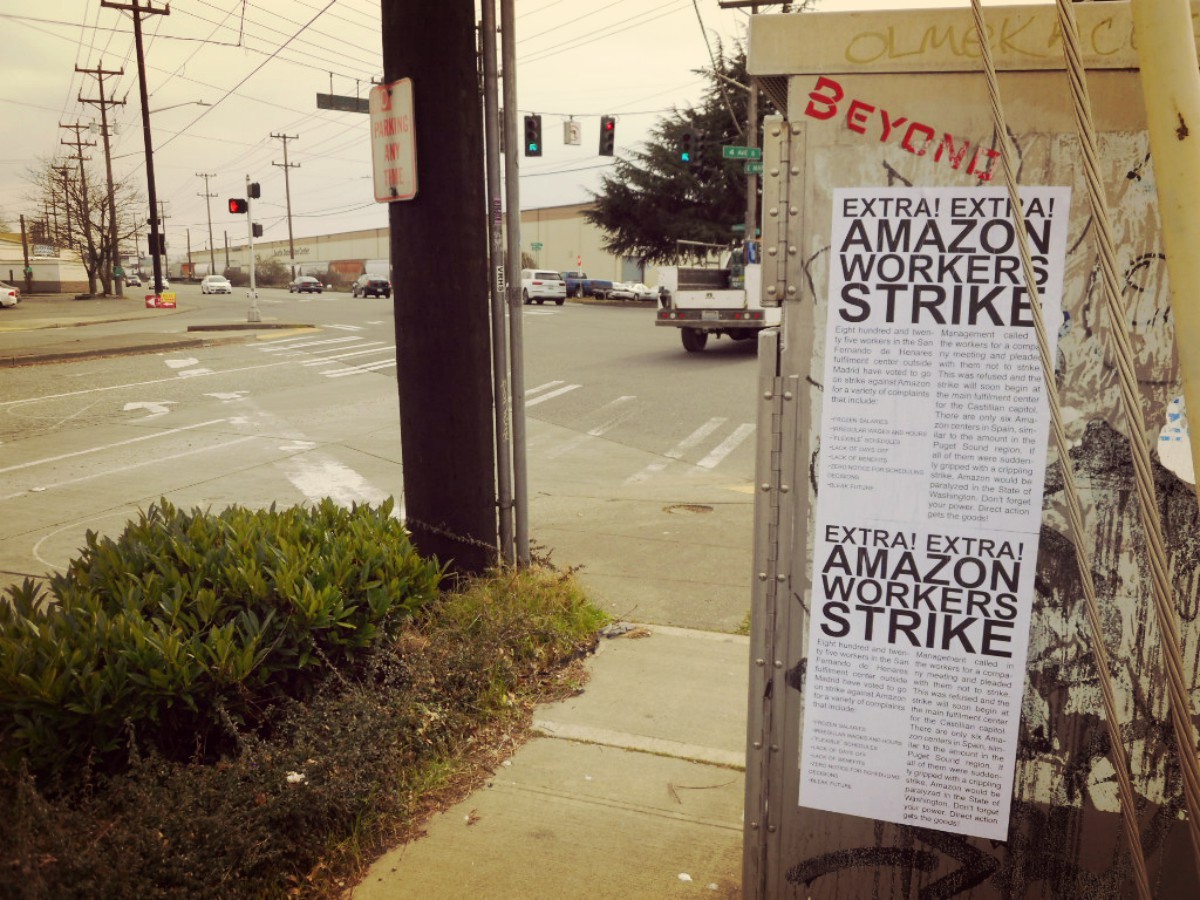Filed under: Action, Capitalism, Featured, Labor, Northwest

The following report comes from Seattle, and details an action that could been pulled off outside of and around Amazon facilities across the country.
On Saint Patrick’s Day, 2018, a group of ten people held an agitational demonstration outside of the new Amazon Flex distribution center (DSE2) in the Georgetown district of Seattle. This facility is located along an industrial waterway in a nondescript logistics terminal called the Seattle Distribution Center. Amazon rents out the front half of one of their long buildings and has filled it with their own high-tech sorting equipment. DES2 is just a small glimpse of the nightmarish future Amazon has in store for the world.
 Our small group stood at the main entrance of this facility with two banners that read NEVER TRUST MANAGEMENT and MAKE AMAZON PAY. Members of the IWW brought union pamphlets and contact-lists sign-ups for employees coming in and out of the warehouse. Prior to the action, the surrounding neighborhood had been covered in posters (link to PDF) that announced the upcoming strike at an Amazon facility outside Madrid. For two weeks, workers at DSE2 saw the bold words AMAZON WORKERS STRIKE IN MADRD on every telephone pole and electrical box. Most of these posters were still up at the time of our action.
Our small group stood at the main entrance of this facility with two banners that read NEVER TRUST MANAGEMENT and MAKE AMAZON PAY. Members of the IWW brought union pamphlets and contact-lists sign-ups for employees coming in and out of the warehouse. Prior to the action, the surrounding neighborhood had been covered in posters (link to PDF) that announced the upcoming strike at an Amazon facility outside Madrid. For two weeks, workers at DSE2 saw the bold words AMAZON WORKERS STRIKE IN MADRD on every telephone pole and electrical box. Most of these posters were still up at the time of our action.
 In the first twenty minutes we were there, two Amazon workers expressed enthusiastic support for our message and took pictures of our banner. Workers from neighboring companies told us they hated Amazon for their entitlement to the shared-space and fully supported everything we were doing. Two dozen Amazon drivers took IWW union material and the warehouse manager (identified by a blue square on his safety vest) looked very nervous and ashamed throughout our visit. He was seen driving off for lunch in a panic as multiple vans were blocking the entrance to take fliers.
In the first twenty minutes we were there, two Amazon workers expressed enthusiastic support for our message and took pictures of our banner. Workers from neighboring companies told us they hated Amazon for their entitlement to the shared-space and fully supported everything we were doing. Two dozen Amazon drivers took IWW union material and the warehouse manager (identified by a blue square on his safety vest) looked very nervous and ashamed throughout our visit. He was seen driving off for lunch in a panic as multiple vans were blocking the entrance to take fliers.
The DSE2 facility is unique in Amazon’s arsenal of dystopian visions. A small crew of pickers and packers work the conveyor belt inside the warehouse. This machine is the primary robot the workers interact with throughout the day and the speed of the conveyor is accelerated when it seems the crew won’t meet their individual goals of 180 packages an hour. It’s unclear if management or an algorithm is in control of the conveyor belt’s speed. In more ways than just these simple mechanics, these warehouse workers are kept in a precarious and exploited state through every aspect of their employment with Amazon.
 When the company decides to “flex up,” workers are called in unexpectedly and given longer hours along the conveyor belt. The only way to get out of these sudden calls is to use a limited number of “voluntary” leave days. If a worker runs out of these days, they will be fired for not “flexing up.” When the company decides to “flex down,” workers are placed on forced leave and given limited hours. Despite the hip and “flexy” internal corporate lingo, this job remains highly insecure and precarious. Those who preserver long enough can apply for the “blue badge upgrade,” a status which afford benefits and higher pay, although this small minority of “blue badges” accounts for no more than 15% of the warehouse workers. Without this absurd token, an employee has a frozen wage and no benefits other than their paycheck.
When the company decides to “flex up,” workers are called in unexpectedly and given longer hours along the conveyor belt. The only way to get out of these sudden calls is to use a limited number of “voluntary” leave days. If a worker runs out of these days, they will be fired for not “flexing up.” When the company decides to “flex down,” workers are placed on forced leave and given limited hours. Despite the hip and “flexy” internal corporate lingo, this job remains highly insecure and precarious. Those who preserver long enough can apply for the “blue badge upgrade,” a status which afford benefits and higher pay, although this small minority of “blue badges” accounts for no more than 15% of the warehouse workers. Without this absurd token, an employee has a frozen wage and no benefits other than their paycheck.
There are also the individual Flex contractors and van drivers, who constitute half of the workforce. During our demonstration, we mostly interacted with these employees, the majority of whom operated unmarked white vans from a delivery company contracted by Amazon. These vans ascended a ramp into the facility, circled around the conveyor belt, and waited to be loaded with Flex orders before descending another ramp. Each of these vans could carry 20-25 orange Amazon boxes. Alongside them are contractors who drive their own vehicles and use the Flex App to secure jobs. One of them even rented an Enterprise van in order to work for Amazon Flex, an arrangement we found troubling for many obvious reasons.
This facility combines every form of the contemporary “gig-economy” and consolidates it in into one location. Aside from the minority of “blue badges,” everyone else is shuffled to the whims of what is most likely an algorithm. Drivers sit in their cars refreshing their Flex App looking for a job, warehouse workers sit at home waiting to “flex up,” and recently inducted “blue badges” wait months for their benefits to finally kick in. The only appealing aspect of this facility is Seattle’s enforced minimum wage of 15 dollars an hour. Further to the south at the BFI4 fulfillment center in Kent, the warehouse employees are paid the local minimum wage of 11.50 an hour. That’s how cheap Jeff Bezos is.
 To make it even worse, the company just removed the heaters from DSE2 (probably because an algorithm told management the median temperature indicated spring) and now the workers shiver 24 hours a day, 7 days a week. Rather than pay his entire US workforce 15 dollars and hour, Bezos gets away with the maximum exploitation allowed by the local laws of capitalism. The contractors who drive their own vehicles into DSE2 are paid per job, not the minimum wage, and their work volume is subject to wild variations. To make it through the month, these contractors often work for multiple companies at the same time. In the ideal world of Jeff Bezos, we’re all supposed to be contractors ready to “flex up” or “flex down” at the flash of a screen.
To make it even worse, the company just removed the heaters from DSE2 (probably because an algorithm told management the median temperature indicated spring) and now the workers shiver 24 hours a day, 7 days a week. Rather than pay his entire US workforce 15 dollars and hour, Bezos gets away with the maximum exploitation allowed by the local laws of capitalism. The contractors who drive their own vehicles into DSE2 are paid per job, not the minimum wage, and their work volume is subject to wild variations. To make it through the month, these contractors often work for multiple companies at the same time. In the ideal world of Jeff Bezos, we’re all supposed to be contractors ready to “flex up” or “flex down” at the flash of a screen.
Our action was a modest success and we interacted with enough workers to have made a clear impression. Of all the unions in the region, IWW is the only one that’s anti-capitalist, and we hope to lead every worker of this “gig economy” into its growing ranks. We hope to encourage others to take autonomous initiative and agitate against the management of these blue-collar workplaces. There’s no good reason why managers should favor Jeff Bezos over the employees. Highlighting their role in enforcing daily exploitation is easy to accomplish. These new Flex facilities are scattered throughout 50 major cities in the United States and small crews of Wobblies or autonomous groups can begin their own forms of agitation and workplace organizing outside the factory gates. Conditions in our current tech-dystopia are so bad the slightest spark could trigger a rebellion. Never forget: direct action gets the goods!




